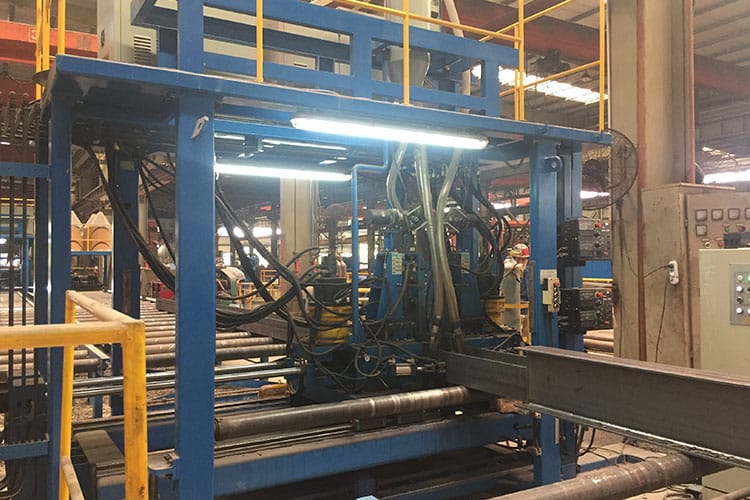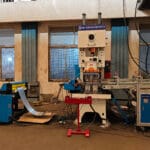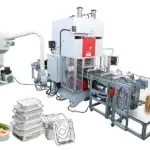H-beams are integral components in the construction industry, providing structural support in various applications such as bridges, buildings, and other large-scale projects. The production of H-beams requires a combination of precision, efficiency, and versatility, which is achieved through advanced production line machines. These machines are specifically designed to handle the intricate processes involved in the fabrication of H-beams, ensuring consistency in quality and maximizing productivity.
Overview of the H-Beam Production Line

An H-beam production line typically includes several key machines and systems that work together to transform raw steel into finished H-beams. These machines include:
- H-Beam Assembly Machine:
- This machine is responsible for the initial assembly of the steel plates to form the H-shape. It precisely aligns the web and flange of the beam before welding, ensuring accurate assembly, which is crucial for maintaining the structural integrity of the final product.
- H-Beam Welding Machine:
- Equipped with gantry-style welding arms, this machine performs the welding of the assembled H-beams. It utilizes advanced welding technologies to ensure deep penetration and strong welds, which are critical for the durability and load-bearing capacity of the beams.
- H-Beam Straightening Machine:
- After welding, slight deformations can occur in the H-beam due to thermal stresses. The straightening machine corrects these deformations, ensuring that the H-beams are perfectly straight, which is essential for their performance in construction.
- H-Beam Shot Blasting Machine:
- This machine cleans the surface of the H-beams by removing rust, scale, and other impurities. The shot blasting process also prepares the surface for further treatment, such as painting or coating, enhancing the beam’s resistance to corrosion and improving its lifespan.
- H-Beam Cutting Machine:
- Precision cutting machines are used to cut the H-beams to the required lengths. These machines ensure clean, accurate cuts that meet the specifications for various construction projects.
- H-Beam Drilling Machine:
- In some cases, H-beams require holes for bolted connections. The drilling machine accurately drills holes in the beams, ensuring they align perfectly with other structural components during assembly.

Key Features and Specifications
- Applicable Workpiece Web Height (h): 200—1800mm
- Applicable Workpiece Web Thickness (tw): 6-32mm
- Workpiece Flange Width (b): 150-800mm
- Applicable Workpiece Flange Thickness (t): 6-40mm
- Applicable Workpiece Length (L): 2000-15000mm
Technical Data:
- Flange Width: 150-800mm
- Flange Thickness: 6-40mm
- Web Height: 200-1800mm
- Web Thickness: 6-32mm
- H-Beam Length: 2000-12000mm
- Assembly and Welding Speed: 200-2000mm/min
- Main Machine Power: 20kW
- Workpiece Height: 200-2000mm
- Workpiece Length: 4000-15000mm
- Welding Speed: 150-1500mm/min

Benefits of H-Beam Production Line Equipment
- Increased Efficiency:
- By integrating multiple processes into a single production line, the H-beam production system significantly boosts efficiency. It reduces the time required to produce each beam, allowing for higher output rates without compromising quality.
- Cost-Effectiveness:
- The combination of assembly, welding, straightening, and other processes into one line reduces the need for multiple standalone machines, thereby lowering the overall equipment costs. Additionally, the space-saving design of the production line minimizes the footprint required for operation, further reducing facility costs.
- Enhanced Quality Control:
- The production line’s automation ensures consistent quality across all stages of H-beam fabrication. This consistency is vital for meeting the stringent standards required in structural applications, reducing the likelihood of defects and rework.
- Versatility:
- The production line is designed to handle a wide range of H-beam sizes and specifications, making it suitable for various construction and manufacturing needs. This adaptability allows manufacturers to cater to different project requirements without needing significant reconfiguration of the equipment.
- Improved Safety:
- Automated processes reduce the need for manual intervention, lowering the risk of workplace accidents. Additionally, the machines are equipped with safety features to protect operators and ensure safe operation throughout the production process.
Applications of H-Beams in Construction
H-beams produced on these advanced lines are used in a variety of construction applications, including:
- Structural Frameworks:
- H-beams form the backbone of many large structures, providing the necessary support for floors, roofs, and walls in buildings and bridges.
- Industrial Buildings:
- H-beams are widely used in the construction of factories, warehouses, and other industrial facilities where large spans and high load-bearing capacities are required.
- Infrastructure Projects:
- H-beams are essential components in the construction of infrastructure such as highways, railways, and power plants, where durability and strength are critical.
Conclusion
Investing in an H-beam profile production line is a strategic decision for manufacturers aiming to produce high-quality structural steel components efficiently and cost-effectively. The advanced machinery and integrated processes offer unparalleled benefits in terms of speed, precision, and versatility, ensuring that the H-beams produced meet the highest standards of quality and performance.
For inquiries, quotes, or further information, please contact us:
- Phone/Wechat/Whatsapp: +86-13394110095
- Email: liu@weldcnc.com
- Website: www.toproductline.com






